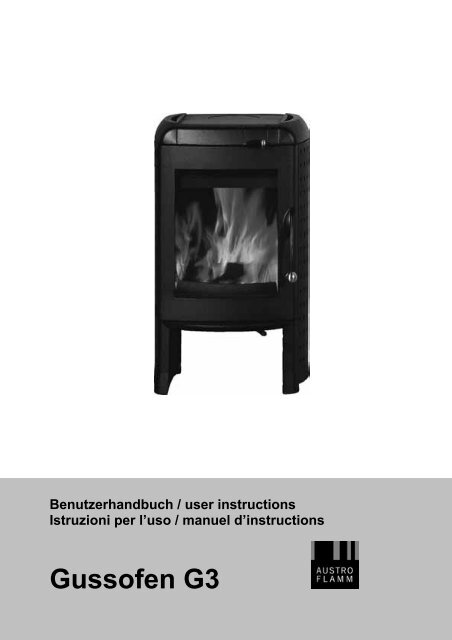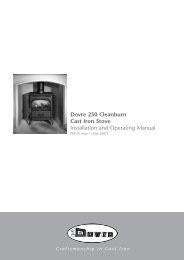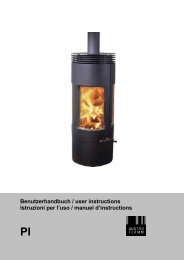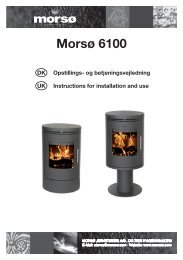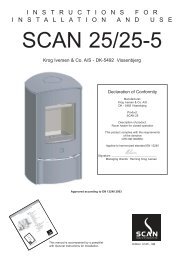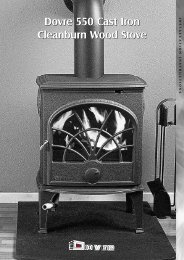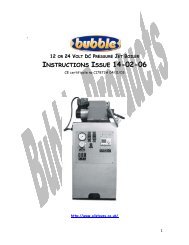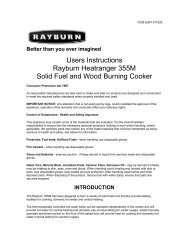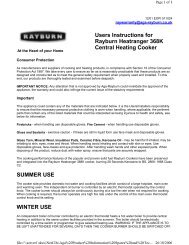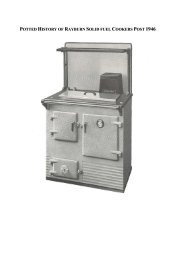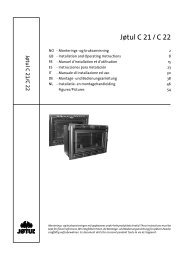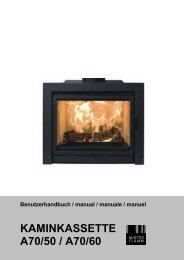PASHA Gussofen G3
PASHA Gussofen G3
PASHA Gussofen G3
Create successful ePaper yourself
Turn your PDF publications into a flip-book with our unique Google optimized e-Paper software.
Benutzerhandbuch / manual / manuale / manuelBenutzerhandbuch / user instructionsIstruzioni per l’uso / manuel d’instructions<strong>PASHA</strong><strong>Gussofen</strong> <strong>G3</strong>
Fig. 1Fig. 2deutsch english italiano françaisAUF – ZU open – closed aperto – chiuso ouvert - ferméSekundärluftschieber secondary air supply Regolazione aria secondaria Coulisseau d’entrée d’air second.Primärluftschieber primary air supply Regolazione aria primaria Coulisseau d’entrée d’air primairedeutsch english italiano françaisInhalt Contents Indice sommaire1. Techn. Daten 1 1. Techn. data 4 1. Dati tecnici 7 1. Caractéristiques 102. Wichtige Informationen 1 2. Important information 4 2. Informazioni importanti 7 2. Infos importantes 103. So bedienen Sie Ihren 3. Correct operation 3. Per un uso corretto della 3. Bien utiliser votreKaminofen richtig 2 of your stove 5 vostra Kaminofen 8 poêle 114. Die wichtigsten 4. The most important 4. Prospetto dei ricambi 4. Principales piècesErsatzteile - Übersicht 3 spare parts - overview 6 principali 9 détachées 12Garantie 13 Guarantee 13 Garanzia 14 Garantie 14
<strong>G3</strong> 1 deutsch1. TECHNISCHE DATENAls <strong>Gussofen</strong> der Bauart 1 ist ein Anschluß aneinen bereits mit anderen Öfen und Herden fürfeste Brennstoffe belegten Schornstein möglich,sofern die Schornsteinbemessung gemäß DIN4705, Teil 3, dem nicht widerspricht.TECHNISCHE DATENHöheBreiteTiefeGewichtGewicht mit KeramikmantelRauchrohrabgang DurchmesserNennwärmeleistung lt. EN 13240Maximale Heizleistung793 mm453 mm510 mm120 kg170 kg130 mm6 kW8kW2. WICHTIGE INFORMATIONENKleinste HeizleistungRaumheizvermögen (abhängigvon der Hausisolierung)3kW48–124 m³Abgaswerte für die Mehrfachbelegung des Schornsteinesnach DIN 4705, Teil 3 bzw. zur Bemessungdes Schornsteines nach DIN 4705, Teil 2Abgasmassenstrom geschlossen 7 g/sAbgastemperatur geschlossen 380 °CMindestförderdruck beiNennwärmeleistung (Nwl)geschlossen 12 Pabei 0,8facherNwl10 PaDie Informationen in diesem Handbuch sindallgemeiner Natur. Nationale und europäischeNormen, örtliche und baurechtliche Vorschriftensowie feuerpolizeiliche Bestimmungen sindeinzuhalten.Allgemeine Sicherheitshinweisezum Betrieb Ihres Kaminofens• Lesen Sie vor der Inbetriebnahme des Ofens dasgesamte Handbuch gründlich durch und beachten Siedie Warnhinweise.• Für den Transport Ihres Heizgerätes dürfen nurzugelassene Transporthilfen mit ausreichenderTragfähigkeit verwendet werden.• Ihr Heizgerät ist nicht zur Verwendung als Leiteroder Standgerüst geeignet.• Durch den Abbrand von Brennmaterial wirdWärmeenergie frei, die zu einer starken Erhitzung derOberfläche des Heizgerätes, der Türen, der Tür- undBediengriffe, der Türgläser, der Rauchrohre undgegebenenfalls der Frontwand des Heizgerätes führt.Die Berührung dieser Teile ohne entsprechendeSchutzbekleidung oder Hilfsmittel wie z.B. Hitzeschutzhandschuheoder Betätigungsmittel (kalteHand), ist zu unterlassen.• Machen Sie Ihre Kinder auf diese besondereGefahr aufmerksam und halten Sie sie während desHeizbetriebes vom Heizgerät fern.• Verbrennen Sie ausschließlich das im Kapitel„saubere Verbrennung“ angeführte, genehmigteHeizmaterial.• Das Verbrennen oder Einbringen von leichtbrennbaren oder explosiven Stoffen, wie leereSpraydosen und dgl. in den Brennraum, sowie derenLagerung in unmittelbarer Nähe Ihres Heizgerätes, istwegen Explosionsgefahr strengstens verboten.• Beim Nachheizen sollen keine weiten, oder leichtbrennbaren Kleidungsstücke getragen werden.• Das Abstellen von nicht hitzebeständigenGegenständen auf dem Heizgerät oder in dessenNähe ist verboten.• Legen Sie keine Wäschestücke zum Trocknenauf den Ofen. Auch Wäscheständer oder dgl. müssenin ausreichendem Abstand vom Heizgerät aufgestelltwerden – Brandgefahr.• Der <strong>Gussofen</strong> <strong>G3</strong> ist keine Dauerbrand-Feuerstelle.• Beim Betrieb Ihres Heizgerätes ist dasVerarbeiten von leicht brennbaren und explosivenStoffen im selben oder in anschließenden Räumenverboten.OfenaufstellungSicherheitsabstände(Mindestabstände) Fig. 21. Zu nicht brennbaren Gegenständen:a > 400 mm b > 200 mm c > 300 mm2. Zu brennbaren Gegenständen und zu tragendenWänden aus Stahlbeton:I a > 800 mm b > 200 mm c > 300 mmII a > 800 mm b > 300 mm c > 300 mmIII a > 800 mm b > 500 mm c > 300 mmI = mit Edelstahlverkleidung,I = mit Konvektionsmantel,III = ohne Konvektionsmantel(a - nach vorne im Strahlungsbereich)(b - seitlich) (c – hinten)Bitte beachten Sie, dass der Aufstellungsraum mind.eine Türe / ein Fenster ins Freie aufweist oder miteinem derartigen Raum direkt verbunden sein muss.Andere Feuerstätten und Dunstabzugshauben dürfennicht im Raumluftverbund mit Feuerstätten betriebenwerden.Technische und optische Änderungen, Satz- und Druckfehler vorbehalten.
deutsch 2 <strong>G3</strong>BodentragfähigkeitPrüfen Sie vor dem Aufstellen, ob die Tragfähigkeitder Unterkonstruktion dem Gewicht Ihres<strong>Gussofen</strong>s standhält.VerbrennungsluftAls Betreiber müssen Sie für ausreichende Verbrennungsluftsorgen. Bei abgedichteten Fensternund Türen kann es sein, dass die Frischluftzufuhrnicht mehr gewährleistet ist, bzw. das Zugverhaltendes Ofens beeinträchtigt wird.RauchrohranschlußFür den Anschluß der Rauchrohre an denSchornstein gibt es zu Ihrer eigenen Sicherheitstrenge Richtlinien. Ihr Kaminofen-Fachhändlerkennt diese. Beauftragen Sie daher unbedingtIhren Fachhändler mit dem Rauchrohranschluß.3. SO BEDIENEN SIE IHREN GUSSOFEN RICHTIGDie erste Inbetriebnahme Ihres<strong>Gussofen</strong>sIhr Kaminofen wurde mit einem umweltverträglichenSpeziallack lackiert. Die Lackoberfläche ist beiAuslieferung Ihres Ofen noch weich. Die Aushärtungdes Lacks erfolgt bei der ersten Inbetriebnahme. DieLackoberfläche darf während dieses Vorganges nichtberührt werden. Der Gußofen muß mindestens1,5 Stunden stark aufgeheizt werden. Bei derAushärtung des Lackes können sichtbare Dämpfefreiwerden. Öffnen Sie daher vor der erstenInbetriebnahme die Fenster, dadurch können dieDämpfe schnell abziehen.BITTE BERÜCKSICHTIGEN SIE: Erst nachmehreren Heizvorgängen ist der Betrieb Ihres Ofensnur mehr vom heimeligen Geruch des verbrennendenHolzes geprägt.Legen Sie 2 – 3 Stk. Anzündhilfen auf den Feuerraumboden.Legen Sie darauf eine handvoll Weichholzspäne.Legen Sie auf diese Späne 1 – 2 ScheiteHolz.Fig 3: AnzündenZünden Sie nun die Anzündhilfen an. Schließen Siedie Feuerraumtür. Sobald die Weichholzspäne gutbrennen, schließen Sie den Primärluftschieber (sieheFig. 2 „ZU“).Zugelassene BrennstoffeTrockenes, gut abgelagertes, naturbelassenes Holz(Hartholz bevorzugt), Holzbriketts.Maximale BrennstoffmengeMaximal aufzugebende Brennstoffmenge: ca. 1,6 kgHolz oder ca. 1,8 kg Holzbriketts.Größere Brennstoffmengen können zu Überhitzungund Beschädigungen am Ofen führen!Saubere VerbrennungDas Brennholz muß trocken (rel. Holzfeuchte < 15 %)und unbehandelt sein. Außerdem muß die richtigeBrennholzmenge verbrannt werden, um einesaubere, emissionsarme Verbrennung zu erreichen.Richtig Feuer machenBereiten Sie alles zum Anheizen vor –Weichholzspäne, Anzündhilfe (wie z.B. AustroflammAnzünder), Brennholz. Fig. 3 gibt Ihnen eineRichtlinie hinsichtlich der Menge an Heizmaterial.Öffnen Sie die Primär- und Sekundärluftzufuhrmaximal. (siehe Fig. 2 „AUF“).Öffnen Sie die Ofentür.Fig. 4: Primärluftschieber schließenSobald die Holzscheite gut brennen, können Sie mitdem Sekundärluftschieber die Heizleistung regulieren(Schieber auf Maximalstellung „AUF“ = maximaleHeizleistung – siehe Fig. 2).Beim Nachlegen gehen Sie prinzipiell wie beimAnheizen vor: beide Luftschieber öffnen, Ofentürevorsichtig öffnen, Holz nachlegen, Türe schließen.Warten Sie, bis das nachgelegte Holz brennt. Dannschließen Sie den Primärluftschieber. Regeln Sie inder Folge die Heizleistung mit demSekundärluftschieber.Symbolabbildungen
Pallas 3 deutschHeizen in der ÜbergangszeitIn der Übergangszeit, d.h. bei höheren Außentemperaturen,kann es bei plötzlichem Temperaturanstiegzu Störungen des Schornsteinzuges kommen,so dass die Heizgase nicht vollständig abgezogenwerden. Die Feuerstätte ist dann mit geringerenBrennstoffmengen zu befüllen und bei weitergeöffneter Stellung des Primärluftschiebers/-reglersso zu betrieben, dass der vorhandene Brennstoffschneller (mit Flammenentwicklung) abbrennt unddadurch der Schornsteinzug stabilisiert wird.Hinweis bei SchornsteinbrandWird falscher oder zu feuchter Brennstoff verwendet,kann es aufgrund von Ablagerungen im Schornsteinzu einem Schornsteinbrand kommen. VerschließenSie sofort alle Luftöffnungen am Kamin und informierenSie die Feuerwehr. Nach dem Ausbrennendes Schornsteins diesen vom Fachmann auf Rissebzw. Dichtheit überprüfen lassen.4. DIE WICHTIGSTEN ERSATZTEILE - ÜBERSICHTDichtungenBezeichnungNr.-Skizze Artikelnr.Dichtung flach 8 x 2 mm, L = 1440 mm 22 710096Dichtung rund 12 mm, L = 1560 mm 20 710338KeramottBezeichnungNr.-Skizze Artikelnr.<strong>G3</strong> Keramott Rückwand 8 716080<strong>G3</strong> Keramott rechts 7 716082<strong>G3</strong> Keramott links 6 716081<strong>G3</strong> Holzfänger 9 716075<strong>G3</strong> Vermiculiteplatte gross 4 716175<strong>G3</strong> Zugumlenkplatte 3 716194<strong>G3</strong> Vermiculiteplatte klein 5 716253<strong>G3</strong> Bodenrost 1 716025<strong>G3</strong> Rüttelrost 2 716122Numerierung Keramott = Einbaureihenfolge!SonstigesBezeichnungNr.-Skizze Artikelnr.<strong>G3</strong> Türglas 21 716065Ofenlack -- 650002Austroflamm Anzünder Dose à 100 Stk. -- 640162Glasreiniger 0,5l -- 640070ZubehörBei Ihrem Fachhändler erhalten Sie Bodenplatten aus Glas oder Stahl, Kaminbestecke und Pflegemittel.WICHTIG: Lassen Sie defekte Teile ausschließlich von Ihrem Fachhändler austauschen. Damit istgewährleistet, daß Ihr <strong>Gussofen</strong> sicher und funktionstüchtig ist und bleibt.Die Feuerstätte darf nicht verändert werden.PflegeZur Glasreinigung verwenden Sie bitte ein Spezialprodukt wie Thermohit Glasreiniger. LackierteOberflächen dürfen nur mit einem Tuch (ev. feucht) gereinigt werden. Für Edelstahloberflächen gibt esebenfalls Spezialreiniger.ReinigungDer Ofen, Rauchgaswege und Rauchrohre sollten jährlich – evtl. auch öfter, z.B. nach der Reinigung desSchornsteines – nach Ablagerungen untersucht und ggf. gereinigt werden. Der Schornstein mussebenfalls regelmäßig durch den Schornsteinfeger gereinigt werden. Über die notwendigen Intervalle gibtIhr zuständiger Schornsteinfegermeister Auskunft. Der Ofen sollte jährlich durch einen Fachmannüberprüft werden
<strong>G3</strong> 4 english1. TECHNICAL DATAAs a stove of construction type 1, it is possible toconnect it to the flue pipe of an existing other stoveor another hearth for solid fuels, as long as thechimney complies with DIN 4705, Part 3.TECHNICAL DATAHeightWidthDepthWeightWeight with ceramic shellFlue pipe outlet diameterNominal thermal output EN 13240Maximum thermal capacitySmallest heating capacity793 mm453 mm510 mm120 kg170 kg130 mm6 kW8 kW3kW2. IMPORTANT INFORMATIONRoom heating capacity (depending onbuilding insulation)48–124 m³Exhaust values for multiple use of the chimney inaccordance with DIN 4705, Part 3 and for thecalculation of the chimney measurements inaccordance with DIN 4705, Part 2Fluegas mass flow closed 7 g/sFluegas temperature closed 380 °CMinimum feed pressureNominal thermal outputclosedat 0.8 timesn. ther. outp.12 Pa10 PaThe installation and operation information given hereis of general nature. National and Europeanstandards, local and building regulations as well asfire prevention laws must be observed during theoperation of the stove.General safety instructions forthe operation of your stove• Thoroughly read the entire manual beforestarting up your stove and observe the cautionnotices.• Your heating unit may not be moved withoutapproved means of transport with sufficient loadbearingcapacity.• Your heating unit is not suitable to be used as astand or as a ladder.• The burning of fuel releases thermal energy thatleads to a substantial heating up of the surface of theheating unit, the doors and operating handlesmounted on the door, door glass, flue pipe and insome cases the front wall of the heating unit. Do nottouch any of these surfaces without respectiveprotective clothing or without the help of accessoriessuch as heat-resistant gloves or a cold hand.• Make your children aware of this particulardanger and keep them at a distance from the heatingunit whenever it is in operation.• Only burn approved fuels and materials listed inthe chapter “Clean Burning”.• The burning or placing of flammable or explosivematerials, such as empty spray cans and such likeinto the firebox as well as the storage of suchmaterials in the immediate vicinity of your heating unitis strictly forbidden due the danger of explosion.• Do not wear loose or flammable clothing whenadding fuel to the fire.• Placing non-heat-resistant objects on theheating unit or in the vicinity of the heating unit isforbidden.• Do not lay laundry onto the stove for drying.Laundry hung up to dry must be kept at a safedistance from the stove because of the danger of fire.• The woodstove <strong>G3</strong> is not suitable for long termheating.• During the operation of your heating unit it isforbidden to use flammable or explosive materials inthe same or an adjacent room to the one in whichyour heating unit is located.•Setting Up Your StoveRequired safety distances (Minimumdistances – see name plate - in Fig. 2)1. to nonflammable objects:a > 400 mm b > 200 mm c > 300 mm2. to flammable objects and to supporting walls ofreinforced-concrete construction with convectionshell:I - a > 800 mm b > 200 mm c > 300 mmII - a > 800 mm b > 300 mm c > 300 mmIII - a > 800 mm b > 500 mm c > 300 mmI = with stainless steel claddingII = with convection claddingIII = without convection cladding(a – toward the front in the radiated area)(b – to the side) (c – to the back)Make sure that the room in which the stove is set uphas at least one door or window into the outside or isdirectly adjacent to such a room. Other fireplaces andextractor hoods must not be operated in the sameroom as the stove.Subject to technical and optical modifications. Formatting and printing errors excepted.
english 5 <strong>G3</strong>Floor load capacityMake sure that the load capacity of the supportingconstruction is sufficient to carry the weight of theentire unit, before the heating unit is installed.Combustion airBeing the user of the stove you must take care of asufficient combustion air supply. Sealed-up windowsand doors may not allow a sufficient combustion airsupply or disturb the draught behaviour of your stove.Stove pipe connectionFor your own safety stringent laws apply forconnecting the stove pipes to the chimney. Yourprofessional dealer or distributor knows these laws.Please have your certified retailer carry out theconnection of your stove.3. CORRECT OPERATION OF YOUR STOVEInitial startup of your stoveYour stove was treated with a special environmentallyfriendly lacquer. The lacquer surface is still soft whenthe stove is delivered. The lacquer will harden whenyour stove is used for the first time. The lacquersurface must not be touched when it is heated for thefirst time. The stove must be initially heated at a hightemperature for at least 1.5 hours. Visible vapors mayappear during the hardening of the lacquer. Thereforeit will be necessary to open the windows during theinitial operation in order let the vapors escape into theoutdoors.PLEASE TAKE NOTE: It takes several heatingsessions before for your stove releases only thepleasant smell of burning wood.Lay one or two logs of wood on the wood chips.Figure 3: Igniting the FireLight the ignition aid. Close the firebox door. As soonas the chips burn well, close the primary air supply.See Figure 2.Approved fuelsDry, well cured and natural wood (hardwoodpreferred), wood briquettes.Maximum amount of fuelMaximum amount of fuel to be added: 1,6 kg woodor appr. 1,8 kg wood briquettes. Larger amounts offuel can lead to overheating and thus damage thestove.Clean burningThe wood must be dry (relative wood moisture< 15%) and untreated. The right amount of woodmust be burned in order to ensure a clean fire thatreleases only small amounts of emissions.Making a firePrepare everything you need for starting the firesoftwood chips, igniter materials (such as Austroflammlighter), wood. Figure 1 provides a good overview ofthe quantity of the materials you will need.Open the primary and secondary air all the way.Move both sliders. See figure 2.Open the stove door.Put ignition aid on the floor of the firebox.Lay soft wood chips onto the paper.Figure 4: Close the Primary AirAs soon as the wood logs are burning well too, youcan regulate the heating capacity with thesecondary air slider. (slider set to the maximum(“AUF”) setting produces maximum heat – seefigure 2.)When adding wood to the fire, follow the sameprocedure as when igniting the fire: Open primaryair, open secondary air, carefully open fireboxdoor, lay wood on the fire, close the firebox door.Wait until the added wood catches fire and isburning. Then close the primary air. Subsequentlyregulate the fire with the secondary air supply.symbol figures
Pallas 6 englishHeating in between seasonsHeating the stove in between seasons, when theoutside temperatures are higher, the flue gases maynot be able to escape completely and this may lead todisturbances in the chimney draught, especially if thetemperatures are rising suddenly. The stove has tobe charged with less wood and the primary air has tobe increased so that the wood can burn down faster(with visible flames) and thus the chimney flue canstabilize.Chimney fireA Chimney fire may occur, due to sooting anddeposits in the chimney, if wrong or humid fuel isused. Close all air inlets on the fireplace/chimneyimmediately and call the fire brigade. Please have anexpert inspect your chimney for cracks and airtightnessafter the burning out of the chimney.4. THE MOST IMPORTANT SPARES—OVERVIEWGasketsDescription Nr. drawing Part numberFlat gasket 8 x 2 mm, 1440 mm long 22 710096Round gasket 12 mm, 1560 mm l 20 710338KeramottDescription Nr. drawing Part number<strong>G3</strong> keramott rear 8 716080<strong>G3</strong> keramott lateral right 7 716082<strong>G3</strong> keramott lateral left 6 716081<strong>G3</strong> wood retainer 9 716075<strong>G3</strong> vermiculit baffle plate large 4 716175<strong>G3</strong> baffle plate 3 716194<strong>G3</strong> vermiculit baffle plate small 5 716253<strong>G3</strong> bottom grate 1 716025<strong>G3</strong> grate 2 716122Keramott numbering = installation instructions!Other partsDescription Nr. drawing Part number<strong>G3</strong> door glass 21 716065Stove lacquer -- 650002Igniter -- 640162Glass cleaner ½ litre -- 640070AccessoriesYou can obtain floor plates made of glass or steel, hearth accessories or care products from your certifieddealer.IMPORTANT: Have defective parts replaced by your certified dealer only. This will guarantee that yourstove functions properly and safely.The fireplace must not be amended.MaintenanceTo clean the glass, please use a specialized product such as Thermohit glass cleaner. Lacqueredsurfaces are to be cleaned only with a cloth (may be damp). Special cleaning agents should also be usedfor stainless steel surfaces.CleaningThe stove, flue outlets and smoke pipes should be cleaned and inspected for deposits every year – ifnecessary more often, e.g. after the cleaning of the chimney. The chimney also has to be cleanedregularly by the chimneysweeper. Your chimneysweeper will inform you of the necessary inspectionintervals. An expert should inspect the stove annually.
<strong>G3</strong> 7 italiano1. DATI TECNICIQuesta stufa-caminetto (Kaminofen del tipo Bauart1) è adatta per essere collegata ad una cannafumaria già utilizzata per altre stufe o fonti di caloreche impiegano combustibili solidi o liquidi, se ledimensioni della canna fumaria lo consentono(norma DIN 4705, Parte 3).Rendimento minimoVolume riscaldabile (m 3 ) (dipendedalle condi-3kW48–124 m 3DATI TECNICIAltezzaLarghezzaProfonditàPesoPeso con rivestimento in ceramicaDiametro uscita fumiRendimento nominale(secondo EN 13240)Rendimento massimo793 mm453 mm510 mm120 kg170 kg130 mm6 kW8 kWValori delle emissioni per allacciamento multiploalla canna fumaria (secondo norma DIN 4705,Parte 3) e per il calcolo delle dimensioni dellacanna fumaria (secondo DIN 4705, Parte 2)Flusso fumi chiuso 7 g/sTemperatura fumi chiuso 380 °CDepressione minimacon rendimentochiusocon r.nom. di0,8 volte12 Oa10 Pa2. INFORMAZIONI IMPORTANTIQuesto manuale contiene informazioni generali.Devone essere rispettate sia le norme nazionale eeuropee, le disposizioni locali e le leggi sul ediliziaed anche le disposizioni dei vigili del fuoco.Avvertenze generali e precauzioninell'impiego della Kaminofen• Prima di mettere in funzione la stufa viraccomandiamo di leggere attentamente l'interomanuale che vi fornisce importanti informazioni eavvertimenti.• Per il trasporto della stufa utilizzate mezzi idonei,la cui portata sia sufficiente a sostenerne il peso.• Non utilizzate la stufa come se fosse una scala oun'impalcatura per salirvi sopra.• In seguito alla combustione si libera energiatermica, che provoca un forte riscaldamento dellasuperficie della stufa e del tubo uscita fumi. Fateattenzione quindi ed evitate di toccare componenticome l'antina, la maniglia, le leve di regolazione delleprese d'aria, il vetro ceramico, il tubo di uscita fumi edeventualmente la parte frontale della stufa senza unaprotezione adeguata, ad esempio un guanto o altriutensili (gancio smuovicenere, ”manofredda”).• Istruite i vostri bambini su questi inconvenienti eteneteli lontani dalla stufa quando è accesa.• Utilizzate solo combustibili idonei indicati nelcapitolo „Combustibili adatti“.• Nella camera di combustione non devonoessere infilate e bruciate sostanze facilmenteinfiammabili od esplosive, come bombolette sprayvuote e simili. E’ severamente vietato lasciare talioggetti nelle immediate vicinanze della stufa (pericolodi esplosione).• Mentre si ricarica legna nella stufa accesa èsconsigliato portare capi di abbigliamento chepossano prendere fuoco facilmente.• Non appoggiate oggetti non resistenti al caloresulla stufa o nelle sue immediate vicinanze.• Non mettete ad asciugare biancheria sopra lastufa. Stendibiancheria o simili devono esserecollocati ad una distanza adeguata dalla stufa(pericolo di incendio).• La stufa non e una stufa da tenere in funzioneininterrotamente.• Quando la stufa è in funzione è sconsigliato l’utilizzo di sostanze facilmente infiammabili oesplosive nella stessa stanza o in stanze adiacenti.•Installazione della stufaDistanze di sicurezza (distanze minime)Fig. 21. Da oggetti non infiammabili:a > 400 mm b > 200 mm c > 300 mm2. Da oggetti infiammabili e pareti portanti incemento armato:I - a > 800 mm b > 200 mm c > 300 mmII - a > 800 mm b > 300 mm c > 300 mmIII - a > 800 mm b > 500 mm c > 300 mmI = con rivestimento in acciaio inoxII = con mantello convettivoIII = senza mantello convettivo(a - anteriormente nell’area di irradiazione)(b – lateralmente) (c - posteriormente)Il luogo in cui installate la stufa deve disporre dialmeno una porta / finestra che dia all’esterno oppuredeve essere collegato direttamente ad un ambientecon accesso all’esterno. Non devono essere messi infunzione nella stessa stanza, altre stufe, caminetti oestrattori fumi.Salvo modifiche di carattere tecnico ed estetico o errori di fotocomposizione e stampa.
italiano 8 <strong>G3</strong>Portata del pavimentoPrima di installare la stufa, accertatevi che la strutturasottostante al punto in cui volete sistemarla sia ingrado di sopportarne il peso.Fornimento d'arai frescaIl gestore del focolare deve garantire la fornitura di unsufficiente volume d'aria fresca. In ambienti con portee finestre chiuse ermeticamente la fornitura d'ariafresca non sempre e'garantita. Questo puoinfluenzare il tiraggio del focolare.Collegamento del tubo di uscitafumiPer garantire la vostra sicurezza, il collegamento deitubi di uscita fumi alla canna fumaria è regolato daapposite norme. Per l’installazione e il collegamentorivolgetevi quindi al vostro rivenditore, che è aconoscenza di tali disposizioni3. PER UN USO CORRETTO DELLA VOSTRAKAMINOFENQuando mettete in funzione lastufa per la prima voltaLa vostra Kaminofen è stata rifinita con una specialevernice ecocompatibile. Al momento della fornitura lesuperfici laccate e verniciate non sono ancoracompletamente indurite. L'indurimento definitivoavviene con il calore che si sviluppa durante la primaaccensione. Durante questa fase, che deve durarealmeno 1,5 ore e a calore intenso, non toccate lesuperfici della stufa e arieggiate bene l'abitazione, pereliminare rapidamente eventuali odori e vaporicausati dall'indurimento della vernice.VI PREGHIAMO DI TENERE CONTO DEL FATTOCHE solo dopo aver acceso la stufa varie volte perun periodo prolungato, percepirete il profumocaratteristico (e piacevole) profumo della legnaardente.Combustibili adattiLegna naturale e non trattata, secca esufficientemente depositata (preferibilmente legnoresistente/duro), tronchetti di legno pressato emattonelle di lignite.Quantità massime di combustibiliLa quantità massima consigliata di combustibileconsigliata: ca. 1,6 kg di legna oppure ca. 1,8 kg ditronchetti di legno pressato per volta. Nonintroducete quantità eccessive di combustibile perevitare un surriscaldamento ed un conseguentedanneggiamento della stufa.Combustione ed ecologiaPer ottenere una combustione corretta con un minimodi emissioni la legna deve essere secca (< 15 % diumidità relativa) e non trattata e non si devonosuperare le quantità di combustibile consigliate. E'assolutamente vietato bruciare rifiuti (sopratutto inplastica).Per una corretta accensionePreparate tutto l'occorrente per accendere la stufa:trucioli di legno morbido , accendifuoco (ad es.Thermohit), carta (non patinata), e legna..Aprite al massimo la presa d'aria primaria e quella perl’aria secondaria, spostando le due levette comeindicato nella fig. 2 “AUF / aperto”.Aprite ora l'antina.Disponete dapprima della carta (non patinata) sulfondo della camera di combustione, sopra di essauna manciata di trucioli di legno dolce e poi 1 o 2ceppi di legna.lIl. 3 : AccensioneDopo aver dato fuoco alla carta, chiudete l'antina eattendete fino a quando i trucioli stanno bruciando perpoi chiudere la presa d’aria primaria.lIl.4 : Chiusura presa d’l'aria primariaQuando anche i ceppi avranno incominciato aprendere ben fuoco, potete regolare il rendimentodella stufa con la levetta dell'aria secondaria(portandola nella posizione massima otterrete ilmassimo del rendimento).Questa operazione va ripetuta per ogni strato di legnache vorrete aggiungere: aprite la presa d'aria primariae quella dell'aria secondaria, poi l'antina (facendoattenzione), aggiungete la legna e richiudete l'antina.Attendete fino a quando anche la nuova legna abbiapreso ben fuoco e poi chiudete nuovamente lapresa d’aria primaria, regolando infine ilrendimento con la levetta dell'aria secondaria.Spiegazione dei simboli
Pallas 9 italianoIl riscaldamento durante le mezzestagioniSe accendete la stufa durante le mezze stagioni,quando le temperature sono più elevate, possonosussistere condizioni di tiraggio sfavorevolli in modotale da non evacuare il fumo interamente,specialmente se le temperature si alzano in modorepentino. Consigliamo quindi di caricare meno legnae di tenere la presa d'aria aperta del tutto perpermettere una combustione più rapida, con unafiamma più alta. In tal modo il tiraggio della cannafumaria si stabilisce.4. PROSPETTO DEI RICAMBI PRINCIPALIGuarnizioniDenominazioneN. su N. art.dis.Guarnizione piatta 8 x 2 x 1440 mm 22 710096Guarnizione tonda 12 x 15600 mm 20 710338Autocombustione della cannafumariaFuliggine e depositi causati da legna inadeguata otroppo umida possono provocare l'autocombustionedella canna fumaria. Chiudete immediatamente tuttele prese d'aria presenti su stufa e camino e chiamate ivigili del fuoco. Fate poi ispezionare la vostra cannafumaria da personale specializzato che ne verifichi lecrepe e la tenuta.KeramottDenominazione N. su dis. N. art.<strong>G3</strong> keramott posteriore 8 716080<strong>G3</strong> keramott lateral destra 7 716082<strong>G3</strong> keramott lateral sinistra 6 716081<strong>G3</strong> fermalegna 9 716075<strong>G3</strong> vermiculite grande 4 716175<strong>G3</strong> tagliafiamme 3 716194<strong>G3</strong> vermiculite piccolo 5 716253<strong>G3</strong> griglia 1 716025<strong>G3</strong> griglia 2 716122Numerazione dei refrattari = istruzioni dimontaggio!Altre partiDenominazione N. su dis. N. art.Vetroceramico antina <strong>G3</strong> 21 716065Vernice -- 650002Accendifuoco -- 640162Detergente vetroceramico 0,5 l -- 640070AccessoriPresso il vostro rivenditore potete acquistare basi di protezione in vetro o acciaio, vari utensili per la stufaed prodotti per la cura e pulizia.IMPORTANTE: per la sostituzione di parti difettose rivolgetevi esclusivamene al vostro rivenditore diKaminofen, in questo modo avrete la garanzia che la vostra stufa continuerà a funzionare in modocorretto e sicuro.Il focolalere non deve essere modificato.PuliziaPer la pulizia del vetro ceramico dell'antina utilizzate gli appositi prodotti in vendita presso i rivenditori distufe (ad es. Thermohit). Le superfici laccate della stufa vanno pulite solamente con un panno(eventualmente umido). Anche le superfici in acciaio inox vanno trattate con appositi detergenti.Stufa, uscite fumi e tubi dovrebbero essere sottoposti ad un ispezione ed una pulizia annuale- senecessario questo puo avenire anche piu spesso , per esempio in seguito alla manutenzione della cannafumaria, che dev'essere anch'essa eseguita periodicamente dal servizio spazzacamino. Sarà proprio ilvostro spazzacamino ad indicarvi i regolari intervalli per la manutenzione. Personale specializzatodovrebbe ispezionare la stufa annualmente.
<strong>G3</strong> 10 français1. CARACTÉRISTIQUES TECHNIQUESLe poêle de type 1 peut être raccordé à unecheminée déjà occupée par d’autres poêles oucuisinières à combustibles solides, à conditiontoutefois que les dimensions de la cheminée selonla norme DIN 4705 Partie 3 l’autorisent.CARACTÉRISTIQUES TECHNIQUESHauteurLargeurProfondeurPoidsPoids avec habillage céramiqueDiamètre à la base du carneauPuissance calorifique selon EN 13240Puissance calorifique maximale793 mm453 mm510 mm120 kg170 kg130 mm6 kW8 kWPuissance calorifique minimaleVolume chauffé (selonl’isolation du bâtiment)3 kW48 – 124 m³Caractéristiques des gaz de combustion en vue de l’installationde plusieurs appareils sur une cheminée selon DIN 4705 Partie3 ou du dimensionnement de la cheminée selon DIN 4705Partie 2Débit de gaz de combustion fermé 7 g/sTempérature des gaz decombustionPression d’extractionminimale à la puissancenominalefermé 380 °Cferméà 0,8 fois lapuissancenominale12 Pa10 Par2. INFORMATIONS IMPORTANTESLes informationes dans ce manuel, sont présentésd’une façon générale. Les normes nationales eteuropéennes, les directives de constructionrégionales ainsi que les accords concernant lasécurité incendie sont à respecter.Remarques générales concernantla sécurité• Lisez attentivement l’ensemble du manuel avantde mettre le poêle en service et respectez lesavertissements relatifs à la sécurité.• Le transport de l’appareil doit toujours êtreeffectué au moyen d’un appareillage de capacitésuffisante.• Le poêle ne doit pas être utilisé commemarchepied ou estrade.• La combustion libère de l’énergie thermique quientraîne un fort échauffement de la surface del’appareil, des portes, des poignées, des vitres desportes, du carneau et parfois de la face avant del’appareil. Ne touchez ces éléments qu’avec uneprotection adéquate, par exemple des gants isolantsou un instrument d’actionnement.• Expliquez bien le risque de brûlures à vosenfants et tenez-les loin de l’appareil lorsque celui-cifonctionne.• Utilisez toujours le combustible autorisé selon lechapitre « Combustion non polluante ».• La combustion ou l’introduction de matières trèsinflammables ou explosives dans le foyer, parexemple de bombes aérosols vides, est strictementinterdite en raison du risque d’explosion, de mêmeque la conservation de tels produits à proximité del’appareil.• Ne rechargez pas le poêle alors que vous portezdes vêtements amples ou en matières inflammables.• Il est interdit de déposer des objets ne résistantpas à la chaleur sur l’appareil ou à proximité.• Ne faites pas sécher de linge sur le poêle.• Les étendages et égouttoirs à linge ou autresdoivent être placés suffisamment loin de l’appareilpour éviter tout risque d’incendie.• Lorsque le poêle est en marche, ne travaillezjamais avec des matières facilement inflammables oucombustibles dans le local où il se trouve ni dans unepièce adjacente.• Le poêle <strong>G3</strong> est un chauffage d'appoint.Installation du poêleDistances de sécurité à respecter(distances minimum – voir également plaqued’identification) (Fig. 2))1. Par rapport à des objets ininflammables :a > 300 mm b > 300 mm c > 300 mm2. Par rapport à des objets inflammables et aux mursporteurs en béton armé :I - a > 800 mm b > 200 mm c > 300 mmII - a > 800 mm b > 300 mm c > 300 mmIII - a > 800 mm b > 500 mm c > 300 mmI = avec habillage inoxII = avec habillage de convectionIII = sans habillage de convection(a : sur l’avant dans la zone de rayonnement)(b : sur les côtés) (c - sur l’arrière)Attention : le local dans lequel vous installez lepoêle doit être pourvu au minimum d’une porte oud’une fenêtre donnant à l’extérieur, oucommuniquer avec une autre pièce donnant àl’extérieur.Sous réserve de modifications techniques et optiques, ainsi que d'erreurs de composition et d'impression.
français 11 <strong>G3</strong>Capacité portante du solAvant d’installer l’appareil, vérifiez si le sol pourraen supporter le poids.Air de combustionEn tant qu’utilisateur, vous devez faire en sortequ’il y ait suffisamment d’air de combustion. Sitoutes les fenêtres et portes sont ferméeshermétiquement , il se peut que l’entrée d’air fraisne se fasse plus correctement voire même que letirage du poêle en soit affecté.Raccordement du carneauPour votre sécurité, des consignes strictes doiventêtre respectées pour le raccordement descarneaux à la cheminée. Votre installateurprofessionnel connaît bien ces règles. Il faut doncimpérativement confier à ce professionnel leraccordement du carneau.3. POUR BIEN UTILISER VOTRE POÊLEPremière mise en serviceVotre poêle a été peint avec un vernis spécial nonpolluant. Cet enduit est encore mou lors de lalivraison. Il ne durcit que lors de la première mise enservice. En attendant, ne touchez pas la surfacepeinte. Laissez le poêle chauffer fortement pendantau moins 1 heure 1/2. Le vernis peut dégager desvapeurs visibles pendant qu’il durcit. Il faut doncouvrir une fenêtre avant la première mise en service,afin d’évacuer rapidement ces vapeurs.ATTENTION : Il faut faire chauffer plusieurs fois votrepoêle pour qu’il ne sente plus que l’odeur habituelledu bois qui brûle.Combustibles autorisésBois naturel sec et bien conservé, briquettes de bois.puis 1 ou 2 bûches.Fig. 3 : AllumageAllumez les aides pour l'allumage.Fermez la porte du foyer.Dès que les copeaux brûlent bien, fermez lecoulisseau d’entrée d’air primaire.Quantité maximale decombustibleAu maximum ca. 1,6 kg de bois ou ca. 1,8 kg debriquettes de bois. N’utilisez pas plus decombustible, sous peine de provoquer une surchauffequi endommagera le poêle.Combustion non polluanteLe bois doit être sec (humidité relative < 15 %) et nontraité. Il doit être utilisé en quantité adéquate pourobtenir une combustion propre et dégageant peud’émissions.Pour bien faire du feuPréparez tout ce dont vous avez besoin pour allumerle poêle : copeaux de bois tendre, allume-feu, papiernon enduit, bois de chauffage. La Figure 3 indique labonne quantité de matériaux à disposer dans le foyer.Ouvrez au maximum les arrivées d’entrée d’airprimaires et secondaires, en déplaçant les deuxcoulisseaux (voir la Figure 2).Ouvrez la porte du poêle.Déposez les aides pour l'allumage (non enduit) surle fond du foyer.Déposez par-dessus une poignée de copeauxFig. 4 : Fermeture du coulisseau d’entrée d’airprimaireDès que les bûches brûlent bien, réglez la puissancede chauffage avec le coulisseau d’entrée d’airsecondaire (position maximale du coulisseau =puissance maximale).Pour recharger le poêle, suivez la même séquenceque pour l’allumage : ouvrez les coulisseaux d’entréed’air primaire puis d’entrée d’air secondaire, ouvrezprudemment la pote du poêle, ajoutez du bois etrefermez la porte.Attendez que le bois ajouté s’enflamme, puisrefermez le coulisseau d’entrée d’air primaire. Réglezla puissance de chauffage avec le coulisseaud’entrée d’air secondaire.Représentation des symboles
Pallas 12 françaisChauffer à la mi-saisonA la mi-saison, c’est-à-dire quand les températuresextérieures sont plus élevées, il arrive que le tiragedu conduit de cheminée soit mauvais à cause del’élévation soudaine des températures : les gaz nesont pas complètement tirés vers le haut.Il faut alors remplir la cheminée avec des quantitésde bois moindres et ouvrir le régulateur d’air primaireà fond afin que le combustible brûle plus vite(formation de flammes), ce qui stabilisera le tirage duconduit.Information en cas d’incendie dans leconduitEn cas d’utilisation d’un mauvais combustible ou d’uncombustible trop humide, il en résulterait des dépôtsdans le conduit qui pourraient alors provoquer unincendie.Fermez aussitôt toutes les arrivées d’air de lacheminée et prévenez les pompiers.Après l’incendie, faîtes vérifier votre conduit par unspécialiste car il peut avoir subi des dommages(félures, détérioration de l’étanchéité).4. PRINCIPALES PIÈCES DÉTACHÉESJointsDésignation N° sur schéma Réf. articleJoint plat 8 x 2 mm, L = 1440 mm 22 710096Joint ronde 12 mm, L = 1560 mm 20 710338Céramique réfractaireDésignation N° sur schéma Réf. article<strong>G3</strong> keramott au centre 8 716080<strong>G3</strong> keramott côte droit 7 716082<strong>G3</strong> keramott côte gauche 6 716081<strong>G3</strong> pare-bûche 9 716075<strong>G3</strong> vermiculite grande 4 716175<strong>G3</strong> déflecteur 3 716194<strong>G3</strong> vermiculite petit 5 716253<strong>G3</strong> grille en bas 1 716025<strong>G3</strong> grille en bas 2 716122Numérotation des céramiques réfractaires =instructions de montage !AutresDésignation N° sur schéma Réf. articlePorte verre <strong>G3</strong> 21 716065Vernis pour poêle -- 650002Allume-feu bois -- 640162Nettoyant pour vitres 0,5 l -- 640070AccessoiresVous trouverez chez votre revendeur spécialisé des plaques de fond en verre ou en métal, desinstruments de cheminée et des produits d’entretien.IMPORTANT : Les pièces défectueuses doivent toujours être remplacées par votre revendeurspécialisé, afin que le poêle reste sûr et en bon état de marche.L'appareil ne doit pas être modifié.EntretienPour le nettoyage de la vitre, utilisez un produit pour vitre comme "Thermohit". Les parties laquéesdoivent être nettoyés uniquement avec un chiffon (éventuellement humide). Utilisez pour les superficiesen inox, des produits spéciaux prévus pour ce revêtement.NettoyageLe poêle, le dispositif d’évacuation des fumées et les tuyaux doivent être contrôlés et en cas de dépôts,être nettoyés au moins une fois par an, si ce n’est plus, par exemple lors du ramonage du conduit decheminée. Le conduit doit également être nettoyé régulièrement par un ramoneur. C’est celui-ci qui vousindiquera dans quelles intervalles un ramonage est nécessaire. Le poêle doit être vérifier une fois par anpar un spécialiste.
GARANTIE / GUARANTEE / GARANZIA / GARANTIE2 Jahre GarantieFür Ihren AUSTROFLAMM-Kaminofen garantierenwir für die einwandfreie Funktion aller Bauteile ausStahl und Guß 2 Jahre ab dem Erstverkaufsdatum.Stahl- und Gußteile, die während der GarantiezeitMaterial- und / oder Verarbeitungsmängelaufweisen, werden gegen Neuteile ersetzt.Wir gewähren keine Garantie auf Verschleißteile(z. B.: Keramott, Dichtungen, Bodenrost),Oberflächenbeschichtungen, Lack, Glas undKeramiken.Voraussetzungen für unsere Garantieleistung sind:1. Ihr AUSTROFLAMM-Kaminofen wurde gemäßdem Benutzerhandbuch betrieben und voneinem Fachmann installiert.2. Der Garantieanspruch wird mit der vollständigausgefüllten Garantiekarte und der Rechnungbei einem AUSTROFLAMM-Fachhändlergeltend gemacht.WICHTIG: Unsere Garantieleistung umfaßt diekostenlose Lieferung der Neuteile. Arbeits- undWegzeiten werden dadurch nicht umfaßt. Eineungerechtfertigte Garantieinanspruchnahme wirddem Betreiber rückbelastet.Two-Year GuaranteeWe guarantee full functionality of allAUSTROFLAMM stove components made of steelor cast iron for a full two years from the date ofpurchase. Steel and cast-iron components whichshow defect in materials or workmanship duringthe guarantee period shall be replaced with newcomponents.We do not guarantee wearable components (suchas Keramott, gaskets, floor grid), surface coatings,lacquer, glass and ceramics.Conditions of the Guarantee:1. Your AUSTROFLAMM stove was installed bya certified professional and is operated inaccordance with the operator’s manual.2. Claims to the guarantee shall be subject to acompletely filled-out Guarantee Card andsubmittal of the original invoice issued by acertified AUSTROFLAMM sales agent.IMPORTANT: Our guarantee includes freeshipping of new components. Work and traveltimes are not included. Unwarranted claims shallbe re-invoiced to the operator.---------------------------------------------------------------------------------------------------------------------------------------Im Garantiefall herausschneiden und Ihrem AUSTROFLAMM-Fachhändler vorlegen!In the event of claims to the guarantee, separate here and present this proof of purchase to your certified AUSTROFLAMM dealer.GARANTIE / GUARANTEE / GARANZIA / GARANTIEHändlerstempel / Dealer’s Stamp / Timbro concessionario /tampon du concessionnaireKaufdatum / date of purchase / Data d’acquisto / dated’achatModellname / Name of Model / tipo del modello / nom duproduitG 3angeschlossen von / Installed by / installato da / raccordée parSerien No. / serial no. / No. di serie / no. de série(siehe Typenschild / See manufacturer’s plate /Vedi targhetta / voir plaque signalétique)
GARANTIE / GUARANTEE / GARANZIA / GARANTIE2 anni di garanziaNoi garantiamo il buon funzionamento di tutti icomponenti in acciaio e ghisa della vostraKaminofen AUSTROFLAMM per una durata di 2anni a partire dalla data della prima vendita. Leparti in acciaio e ghisa che dovessero presentaredifetti di materiale e/o lavorazione durante ilperiodo di garanzia verranno sostituite con partinuove.Sono escluse dalla garanzia le parti soggette adusura (ad es. elementi in keramott, guarnizioni,griglie della camera di combustione), nonché irivestimenti delle superfici, vernici, vetroceramicoed elementi in ceramica.Per avere diritto alle prestazioni di garanzia:1. La vostra Kaminofen AUSTROFLAMM deveessere installata da personale specializzato efatta funzionare osservando le istruzioni delmanuale.2. Occorre presentare la cartolina di garanziacorrettamente compilata e lo scontrino / lafattura / la ricevuta fiscale ad uno deirivenditori AUSTROFLAMM.IMPORTANTE: la nostra Garanzia copre lafornitura gratuita delle parti nuove e non includené la durata dell'intervento né la trasferta. I costicollegati ad una richiesta ingiustificata diprestazione di garanzia saranno addebitatiall'utente.Garantie 2 ansNous garantissons le bon fonctionnement de tousles éléments en acier et en fonte des poêlesAUSTROFLAMM pendant 2 ans à compter de ladate du premier achat. Les pièces en acier et enfonte présentant un défaut de matériau et/ou defabrication pendant la durée de la garantie serontremplacées par des pièces neuves.Nous déclinons toute garantie pour les piècesd’usure (par ex. céramique réfractaire, joints, grillede fond), les joints de surfaces, le vernis, les vitreset les céramiques.Conditions d’application de la garantie :1. Votre poêle AUSTROFLAMM doit avoir étéinstallé par un spécialiste et utiliséconformément au mode d’emploi.2. La demande de garantie doit être présentée àun revendeur spécialisé AUSTROFLAMM enmême temps que la carte de garantiecomplétée et que la facture.IMPORTANT : Notre service sous garantiecouvre le remplacement gratuit par des piècesneuves. Les temps de travail et de déplacementne sont pas inclus. En cas de demande abusived’application de la garantie, nous présenterons àl’utilisateur une facture correspondante.Austroflamm GmbH, Austroflamm Platz 1, 4631 Krenglbach, Austria, Stand 05/06-------------------------------------------------------------------------------------------------------------------------------------In caso di richiesta di garanzia, ritagliare la cartolina e presentarla al rivenditore AUSTROFLAMM!Découpez selon les pointillés et présentez ce coupon à votre revendeur AUSTROFLAMM.GARANTIE / GUARANTEE / GARANZIA / GARANTIEKunde / Customer / cliente / clientMarkeStampFrancobolloaffranchiran/ to / per / pour


